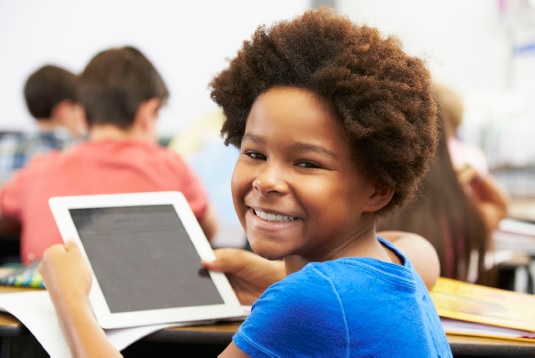The Flipped Classroom
One of the most common blended learning models used in secondary education settings is the flipped classroom. What is a flipped classroom? What are its benefits? How does it work?
In a flipped classroom, students independently learn the instructional content on a computer off-site so that class time can be used for practice, activities, discussions, or projects .
A flipped classroom bears benefits for students and teachers alike. In the book Blended: Using Disruptive Innovation to Improve Schools, authors Michael B. Horn and Heather Staker describe one way that shifting content instruction to the computer benefits students:

If some students don’t understand what is presented in a real-time classroom lecture, they have little recourse. The teacher can try to slow down or speed up to adjust to differentiated needs, but inevitably what is too fast for one student is too slow for another. Moving the delivery of basic instruction to an online format gives students the opportunity to hit rewind or fast-forward according to their speed of mastery.1
The flipped classroom not only lets students assume some control over the pace at which they learn online content, but also lets them have some control over how they learn it, or when or where they use a computer to access that content.
Another benefit of this model is that it helps students learn to be accountable, self-directing, and self-reliant. Learning lesson material online outside of school becomes their responsibility—in effect, teaching students to take greater ownership in achieving their educational goals. This shift in responsibility from the teacher to the student jump-starts students’ motivation to succeed.
What are the benefits of this model for teachers? One big benefit of a flipped classroom is that it helps teachers use class time more effectively. Since students are engaged in activity-based learning while in the classroom rather than passively receiving the content being presented, teachers are freed up to move around the room and provide personalized assistance to small groups and individual students.
The computer-based part of blended learning provides teachers with another benefit: student performance data. Computer software typically gathers highly detailed information on each student—a luxury that schedule-challenged teachers in a real world classroom just don’t have. Teachers can access and use the data to inform instruction and intervene with struggling students in a timely, targeted manner.

Flipping the Classroom with Reading Horizons
So how would a flipped classroom model work with a Reading Horizons program? Following is an example of how Reading Horizons Elevate™ could be implemented in a flipped classroom.
Students complete Reading Horizons Elevate software lessons outside of class as homework on a schedule either prescribed by the teacher or self-directed by the student. After students have completed the software lessons, teachers use class time to review the skill with the whole class. Students actively participate in skill reviews and demonstrate skills mastery by engaging in dictation, using Transfer Cards, and/or completing Enrichment Activities found at the end of the skills lessons in the Reading Horizons Elevate Teacher’s Manuals.
Students can also use the optional Reading Horizons Student Workbook in connection with their online learning in a couple of different ways. Students can be assigned to complete accompanying Student Workbook pages for homework as they complete each lesson on the software. Or, students can complete Student Workbook lessons during teacher-guided instruction and practice in class.*
* For a detailed description of how to implement Reading Horizons Elevate in a flipped classroom, click on the following link.
Suggested Implementation of Blended Learning Model: Flipped Classroom ›
[Notes]
1 Michael B. Horn and Heather Staker, Blended: Using Disruptive Innovation to Improve Schools (United States: Jossey-Bass, 2014), 43.
The images on this page are adaptations of graphics originally appearing in the book Blended: Using Disruptive Innovation to Improve Schools.